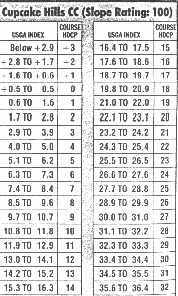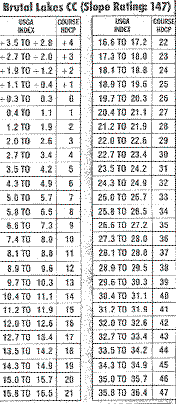Ready or not, Slope's future is now
Most states prepared to meet upcoming deadline, but are golfers?
BY GARY VAN SICKLE
Tip No. 3 from The Guide to Terrorism in Golf Writing: "Mention Slope System, square grooves or the lateral hazard rule in your lead paragraph. Readers will run from the room, screaming. Guaranteed."
Let's try it, shall we?
Here's everything you ever wanted to know about the Slope System and then some, including the fact that as of March 31, Slope will be the one and only handicapping method recognized by the United States GA.
So, is anybody still out there?
Oh. Good. Here's the deal. The USGA's Slope System has come of age. It already has in many states, but now it has to everywhere by USGA mandate. Never mind that Slope is misunderstood by many and under-used by too many.
Slope is here to stay. And it's simple to use. Yes, it's a little difficult to explain and fully comprehend, but how many of us know how a microwave oven works? Yet we can heat up left-over meatloaf.
Using Slope is about that easy. All you need to know is your USGA Handicap Index � you know, that number with the decimal point that replaced your old handicap. When you play at another course, simply check the official Slope conversion chart in the golf shop before you tee off. It tells you your handicap, based on the degree of difficulty of the course you're about to play. If the course is considerably tougher than where you normally play, your handicap will go up. If it's considerably easier, it goes down.
We'll get to some examples later. Let's talk Slope concept first. (Are you still out there?)
The reason for Slope is to create a universal standard, to make 12-handicappers from easy nine-hole courses equal to 12-handicappers from, say, PGA West or Pine Valley.
Under the old handicap system, they weren't equals, says Warren Rebholz, director of the Minnesota GA and a guy who'll be busy this summer when the U.S. Open comes to Hazeltine National GC in suburban Minneapolis.
"Before Slope, if you were an 8-handicap at a difficult golf club like Hazeltine, you could beat an 8 from anywhere else, easy," Rebholz says. "After Slope, it significantly reduced that advantage.
"Even more important, when guests are invited to a harder course, they get some help. I'm an 8 at Highland Park, and when I go to Hazeltine, I get to be an 11.
"You see different names winning the tournaments here now. The system works."
The concept makes sense, assuming all courses are rated in a uniform manner. Some of the decimal-pointed numbers and conversion charts appear intimidating to those new to the system. Slope still suffers, in the minds of many, from a comprehension gap.
"Slope is totally accepted, but not totally understood, even to this day, even by some of our own directors," says Eugene Haas, head of the Wisconsin State GA. "If you asked any knowledgeable golfer how Slope is used, he'd have a problem. He doesn't understand it. But I don't think he cares. He just knows that he gets a couple of extra pops when he goes to a tougher course, and that helps him, so he thinks it's good."
How much difference can Slope make? And how do you use it? Check out the Slope conversion charts on these pages for two fictional courses, Cupcake Hills, a flat, fairly easy course with a low Slope rating of 100, and Brutal Lakes, a demanding course with a high rating of 147.
First, find your USGA index rating that you've established by posting scores. Let's say yours is 25.4, which means you only occasionally break 100. At Cupcake Hills, look up 25.4 in the index column and match it with the course handicap column. It says 22, which is what your handicap would be when you play Cupcake Hills. When you play a monster like Brutal Lakes, though, your handicap goes up to 33.
Low handicap players don't notice much difference. A 3.3-handicapper would be a 3 at Cupcake Hills and a 4 at Brutal Lakes. An 18.1-handicapper would get eight more strokes at Brutal Lakes than at Cupcake.
What makes Slope better than the old rating system7 A matter of viewpoint. The old ratings were based on the abilities of a player with a scratch, or 0, handicap. A course rating of 71.9 meant that the USGA's ideal scratch player should shoot around 72.

That was swell, but the average golfer's handicap is more like 22. A course rated three shots tougher for a scratch player would play six or eight shots tougher for a lesser-skilled player.
Slope was based on a bogey golfer. A national slope average of 113 was established, based on 1.13, which research showed was the average stroke increase from one handicap to the next. The higher the slope number, the tougher the course � for the mythical bogey golfer.
Slope has been alternately embraced and shunned in various parts of the country. Colorado and Wisconsin went for it immediately. Colorado began using it in 1981 and Wisconsin followed the following year. California, with its huge golfing population, didn't make the switch to Slope until last year. And almost half of the 679 golf courses in Texas have yet to be Slope-rated, or have even applied to be rated. Upstate New York also has been a Slope straggler.
"I'm seeing an increase in applications now," says William Penn, head of the Texas GA, "but no way in hell can we get to 300 courses by March 31."
Estimates are that more than three-fourths of America's courses will be Slope-friendly by the deadline.
"There are pockets that aren't on Slope yet," says Jay Mattola of the Metropolitan GA, which converted to Slope in 1986. "Usually it's where the state golf associations, for one reason or another, have dropped the ball.
"Several problems have worked against Slope in Texas. One is the sheer size of a state in which only Penn and the TGA and the Houston GA rate courses. Another is the large number of public courses but a dearth of golf associations in the state.
What's the impact of having unrated courses? Not that much, but it means that better players at an unrated club won't have an official USGA Handicap Index and won't be eligible for USGA competitions.

In California, which already had a progressive course-rating system, officials were in no hurry to jump on the Slope boat until they were positive it wouldn't sink.
Slope was well-received in its first year, however, Bob Thomas of the Southern California GA says. By March, the phone calls and questions tailed off.
What made it work was an extensive marketing and education program, plus a decision not to issue a home-course handicap, just a handicap index.
"That forces golfers to know how the system works and to use it," Thomas says.
Slope passed the test in last year's team matches, which feature 6,000 golfers representing their clubs on 16-member teams in six weeks of round-robin matches. Handicaps are used. Last year, they were Slope handicaps for the first time.
"They saw the difference, clearly," Thomas says. "They saw the theory behind the system, that the harder the course, the more strokes the bogey golfer needs."
Slope's biggest hurdle is getting players to use it.
"We aren't kidding ourselves," Mattola says. "We still aren't totally successful in getting people to identify their handicap with their Slope index rating. We still haven't gotten them to say, 'I'm a 10.6, or whatever.'
"A lot of people arrive at the first tee without making their index conversion."
Says Minnesota's Rebholz, "Golfers here understand Slope. It's just a matter of whether they bother to use it on the first tee."
|






